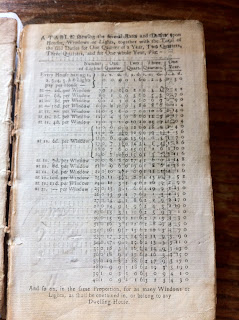 |
| Window tax rates from 1769 |
The attached image is take from a diary that is in my possession. The diary is from 1769. It shows the tax charged on households based on the number of windows that their houses had. A clear attempt to make those with more money (biggest houses) pay more tax than poorer people (smallest houses). There is suggestion that this tax gave us the saying "daylight robbery."
 |
| 1769 diary of James Farrer |
However I need some help trying to understand how life in 1769 was for normal people so that I can really contextualise this book.
James Farrer's wealth came from his family and his associations; the Farrer family were given wealth many, many years ago without the need to tread on the poorer classes in the way that the Industrial revolution allowed people in the middle classes to amass wealth.
There are many examples in the diary that show how people were prepared to forego their own identities to progress socially. The Hawksworth family and the Farrer family both changed their name to Fawkes to inherit the land and title of the Fawkes family.
Not all wealth acquisition requires the expolitation of the lower classes.
If you have an interest in local history or if you have knowledge of any of these families (Hawskworth, Farrer, Saville, Rockingham, Lascelles to name but a few) please contact me.
I have so many questions regarding the Farrer family that lived at Barnburgh Grange. Wikipedia has provided me with much. My geneaology skills have been tested as I have attempted to recreate the Farrer family tree around the 18th century. If you can help, please contact me via this blog or through twitter @cparkie.
Hello from 2016 in California, USA!
ReplyDeleteI've been researching the Lords of the Manor of Saddleworth. James Farrar (1721-1791) was the last lord. Today I spent researching his family. Found lots of Farrars/Farrers and lots of conflicting information. Your diary looks interesting.
Hi Craig,
ReplyDeleteIn my family tree I have a family called Winterbottom who lived in Strinesdale, Saddleworth. In a will of 1714 one Robert Winterbottom bequeathed the remains of a lease to his son Henry. This lease was on a property rented from James Farrer Esq. In 1742 Henry died intestate, but his property was inherited by his son John. In 1766, John entered a 150 year lease with the same James Farrer Esq. I have copies and transcripts of these documents from 1714, 1742 and 1766 obtained from Oldham Local Studies.
Hi Paul. Thanks for your reply. As Lord of the Manor, James Farrer owned many properties both in Saddleworth and in Barnburgh. He was, I believe, one of about 30 Lords of the Manor of Saddleworth holding the title at the same time in the 18th Century.
DeleteI guess I was interested in the possibility of these Winterbottoms being mentioned in James Farrer's diary? And, I suppose the other question would be: which James Farrer wrote the diary? Thanks
DeleteSorry, minor error - Henry died 1741 not 1742,
ReplyDelete